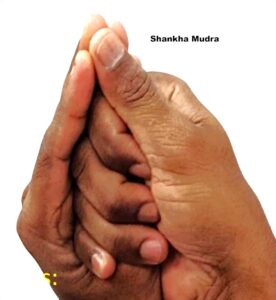Shankha Mudra
Introduction
Mudras are symbolic hand gestures in yoga that influence prana (vital energy) and affect physical, mental, and spiritual well-being. Shankha Mudra, named after the conch shell (Shankha in Sanskrit), is a powerful mudra that stimulates energy, enhances vitality, and promotes respiratory and cardiovascular health.
This mudra is often used in pranayama, meditation, and yoga therapy. The shape of the folded hand resembles a conch shell, symbolizing divine sound, energy, and awakening of inner power.

Meaning
- Shankha = Conch shell, symbolizing energy, purity, and auspiciousness.
- Mudra = Yogic seal or gesture.
Purpose: To activate prana, enhance vitality, and support respiratory and cardiovascular functions, while harmonizing physical and subtle energy systems.
How to Perform (Practice)
- Sit comfortably in Sukhasana, Padmasana, or Vajrasana, keeping the spine straight.
- Relax shoulders, arms, and hands.
- Come into a sitting position with your hands in front of your solar plexus. Wrap all four fingers of your right hand around your left thumb.
- Keep the fingers of your left hand together and pointing upward.
- Rotate your right hand until the thumb points upward and join the tips of your right thumb and left middle finger.
- Bring your hands, now in the form of a conch shell, in front of your breastbone.
- Close your eyes, breathe slowly, and visualize energy circulating throughout the body.
- Maintain the mudra for 5–15 minutes, gradually increasing duration with practice.
Tip: Keep hands relaxed; focus on breath and energy flow.
Benefits
Physical Benefits
- Stimulates respiratory system and lung capacity.
- Supports cardiovascular health and circulation.
- Enhances energy and vitality.
- May aid in cold, cough, or asthma symptoms when practiced with pranayama.
Mental & Emotional Benefits
- Promotes calmness and mental clarity.
- Reduces stress, anxiety, and mental fatigue.
- Enhances focus, mindfulness, and emotional stability.
Spiritual Benefits
- Awakens pranic energy and subtle vibrations, similar to the conch sound in spiritual practices.
- Supports meditation and energy channeling in the body.
- Encourages purity of mind and alignment of chakras.
Contraindications
- Finger, hand, or wrist injuries.
- Respiratory conditions should be mild; severe conditions should practice under supervision.
- Avoid over-practice if discomfort occurs in hands, wrists, or shoulders.
Anatomy & Physiology
- Musculoskeletal: Activates intrinsic hand muscles, stabilizes fingers, engages forearm muscles.
- Circulatory system: Improves blood flow to hands, arms, and chest.
- Nervous system: Stimulates sensory nerve endings, promoting alertness and energy perception.
- Respiratory system: Supports lung function and pranic flow.
Kinesiology
- Index, middle, and ring fingers folded; thumb lightly pressing them; little finger extended to form the “conch shell” shape.
- Wrists neutral, shoulders relaxed.
- Hands resting on thighs or in front of chest.
- Enhances hand stability, proprioception, and pranic energy circulation.
Neurology
- Stimulates peripheral nerve endings, enhancing mind-body coordination and awareness.
- Activates parasympathetic system for relaxation and sympathetic system for vitality.
- Supports cortical areas associated with attention, memory, and focus.
- Enhances subtle energy perception and circulation during meditation.
Duration of Mudra
- Beginners: 5 minutes.
- Intermediate: 10–15 minutes.
- Advanced: 20–30 minutes during meditation or pranayama.
Tip: Regular daily practice enhances vitality, focus, and respiratory function.
Counter Mudra
- Shaant Mudra: To calm after energetic practice.
- Prana Mudra: To boost energy along with Shankha Mudra.
- Apana Mudra: To release stagnant energy post-practice.
Conclusion
Shankha Mudra is an energy-activating mudra that enhances vitality, respiratory and cardiovascular health, and mental clarity. Regular practice provides physical, mental, and subtle energy benefits, making it ideal for meditation, pranayama, and energy-balancing yoga routines.
FAQ
Q1. Can beginners practice this mudra?
Yes, it is simple and safe for all levels.
Q2. Can it help with respiratory or energy-related issues?
Yes, it improves lung function, pranic circulation, and general vitality.
Q3. How long should it be practiced daily?
5–15 minutes for beginners; up to 30 minutes for advanced practitioners.
Q4. Can it be combined with pranayama or meditation?
Yes, it enhances breath-focused practices and meditation.
References
- Swami Satyananda Saraswati, Asana, Pranayama, Mudra, Bandha.
- B.K.S. Iyengar, Light on Yoga.
- Hatha Yoga Pradipika – Mudras for energy activation and respiratory health.
- Gheranda Samhita – Mudras for vitality, mental clarity, and subtle energy flow.
- Kuvalayananda, Yoga Mimamsa Journal.
